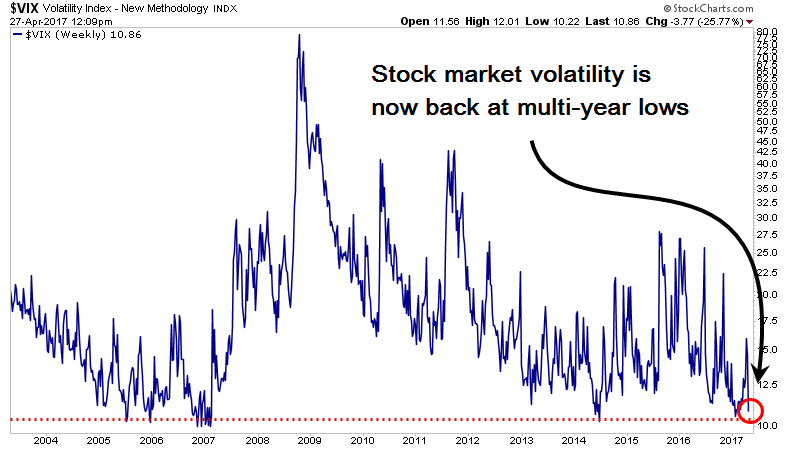The following is a summary of our recent Big Picture broadcast, which can be accessed on our site here or on iTunes here.
When it comes to the stock market, knowing how to define risk is the first place investors should start. Part of the problem many people have is, when risk appears to be highest, it is often actually low. Take for instance the few years after the last crash in 2009: up to 2012, many were anticipating another crash, Puplava stated.
“They forgot that the crash already happened,” he said. “In 2009, everyone was fearful. Today, I would say at best, everybody’s complacent.”
This complacency is the result of misunderstanding risk. Many investors, including academics, tend to think of risk as a function of volatility, which is measured by the VIX. The VIX spiked in late 2008 to a high of around 80. Today, it's sitting near 10.
The public was not thinking about risk, stock market valuations, or the price other investors were willing to pay in 1999 to 2000. The same was true in 2005 and 2007.
But these are precisely the times we should be focusing on risk, Puplava stated.
“Risk is really more a function of price,” he said. “Risk seems to surface more when you have a positive economic environment. That’s when people are euphoric … and feeling optimistic. ... When markets become pricier, they become more risky.”
Recognizing Elevated Risk
It isn’t useful to focus on a probable trigger for a risk event, Puplava stated. The issue is, the ultimate trigger often turns out to be what most people don't see.
A better way to analyze risk is to note its correlation with high prices.
“High prices imply loses rather than potential gains,” Puplava said. “If the stock market is up 275 percent, people tend to extrapolate. … That’s when you’re most at risk.”
Right now, we’re in the second most highly valued stock market in history, Puplava added. Along with this comes an absence of risk aversion, which is ultimately the result of excessive optimism and inadequate skepticism.
Ultimately, this puts returns in peril. The issue here is, when rates of return are low, as they have been, and performance in risk assets are high, everyone starts chasing risk, Puplava stated.
“The greater risk you’re taking on, you would expect to be compensated (for) by a higher rate of return,” he said. “The problem is, we have seen the lowest interest rates in history. … The bar for each successively riskier investment has been set lower than any time in my entire investment career.”
This has led to elevated P/E ratios on all major indices, narrower credit spreads, undisciplined investor behavior, increases in leverage and demand for all asset classes.
Controlling Risk
The reality is, right now, these conditions pose a threat to both stock and bond investors.
“I still think stock markets are probably going to go higher, because markets usually have a spectacular blow-off in the final phase, as the market peaks,” Puplava said.
Right now, Puplava is focused on de-risking client portfolios, raising cash and moving into floating rate bonds.
Because no one knows what the trigger event for a risk-off phase is going to be, it’s better to be in safer investments, such as floating bonds, which will produce additional yield as the Fed raises interest rates.
“I really don’t know what the exact trigger event will be or when the turning point will come, and I don’t think there’s anyone out there smart enough to tell you that,” Puplava said. “We do know this: when prices get elevated, as they are today … risk is rising, and you need to be cognizant of that.”
Become a subscriber and gain full access to our premium weekday interviews with leading guest experts by clicking here.







